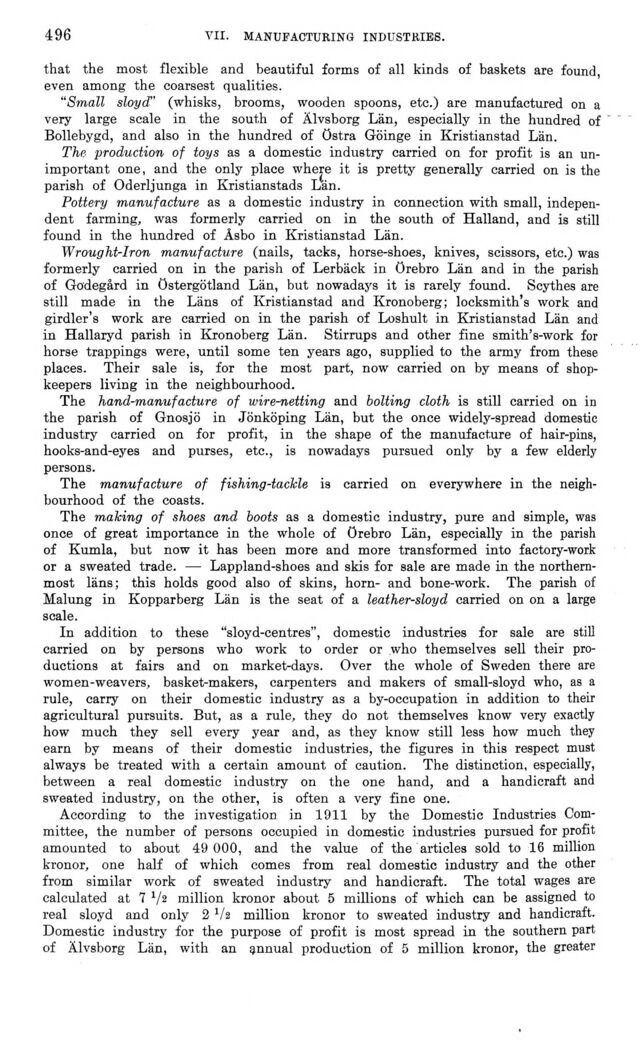
Full resolution (JPEG) - On this page / på denna sida - VII. Manufacturing Industries. Introd. by [G. Sundbärg] K. Åmark - 12. Handicrafts and Domestic Industries. [By A. Raphael] - Domestic Industries. By S. Odén

<< prev. page << föreg. sida << >> nästa sida >> next page >>
Below is the raw OCR text
from the above scanned image.
Do you see an error? Proofread the page now!
Här nedan syns maskintolkade texten från faksimilbilden ovan.
Ser du något fel? Korrekturläs sidan nu!
This page has never been proofread. / Denna sida har aldrig korrekturlästs.
496
vii. manufacturing industries.
that the most flexible and beautiful forms of all kinds of baskets are found,
even among the coarsest qualities.
"Small sloyd" (whisks, brooms, wooden spoons, etc.) are manufactured on a
very large scale in the south of Älvsborg Län, especially in the hundred of
Bollebygd, and also in the hundred of östra Göinge in Kristianstad Län.
The production of toys as a domestic industry carried on for profit is an
unimportant one, and the only place where it is pretty generally carried on is the
parish of Oderljunga in Kristianstads Län.
Pottery manufacture as a domestic industry in connection with small,
independent farming, was formerly carried on in the south of Halland, and is still
found in the hundred of Åsbo in Kristianstad Län.
Wrought-Iron manufacture (nails, tacks, horse-shoes, knives, scissors, etc.) was
formerly carried on in the parish of Lerbäck in Örebro Län and in the parish
of Godegård in Östergötland Län, but nowadays it is rarely found. Scythes are
still made in the Läns of Kristianstad and Kronoberg; locksmith’s work and
girdler’s work are carried on in the parish of Loshult in Kristianstad Län and
in Hallaryd parish in Kronoberg Län. Stirrups and other fine smith’s-work for
horse trappings were, until some ten years ago, supplied to the army from these
places. Their sale is, for the most part, now carried on by means of
shopkeepers living in the neighbourhood.
The hand-manufacture of wire-netting and bolting cloth is still carried on in
the parish of Gnosjö in Jönköping Län, but the once widely-spread domestic
industry carried on for profit, in the shape of the manufacture of hair-pins,
hooks-and-eyes and purses, etc., is nowadays pursued only by a few elderly
persons.
The manufacture of fishing-tackle is carried on everywhere in the
neighbourhood of the coasts.
The making of shoes and boots as a domestic industry, pure and simple, was
once of great importance in the whole of Örebro Län, especially in the parish
of Kumla, but now it has been more and more transformed into factory-work
or a sweated trade. — Lappland-shoes and skis for sale are made in the
northernmost läns; this holds good also of skins, horn- and bone-work. The parish of
Malung in Kopparberg Län is the seat of a leather-sloyd carried on on a large
scale.
In addition to these "sloyd-centres", domestic industries for sale are still
carried on by persons who work to order or who themselves sell their
productions at fairs and on market-days. Over the whole of Sweden there are
women-weavers, basket-makers, carpenters and makers of small-sloyd who, as a
rule, carry on their domestic industry as a by-occupation in addition to their
agricultural pursuits. But, as a rule, they do not themselves know very exactly
how much they sell every year and, as they know still less how much they
earn by means of their domestic industries, the figures in this respect must
always be treated with a certain amount of caution. The distinction, especially,
between a real domestic industry on the one hand, and a handicraft and
sweated industry, on the other, is often a very fine one.
According to the investigation in 1911 by the Domestic Industries
Committee, the number of persons occupied in domestic industries pursued for profit
amounted to about 49 000, and the value of the articles sold to 16 million
kronor, one half of which comes from real domestic industry and the other
from similar work of sweated industry and handicraft. The total wages are
calculated at 7 V2 million kronor about 5 millions of which can be assigned to
real sloyd and only 2 V? million kronor to sweated industry and handicraft.
Domestic industry for the purpose of profit is most spread in the southern part
of Älvsborg Län, with an qnnual production of 5 million kronor, the greater
<< prev. page << föreg. sida << >> nästa sida >> next page >>